Haswell and GK110 vs. Ivy and GK104: DigitalStorm Virtue System Review
by Dustin Sklavos on June 23, 2013 12:00 PM ESTSystem and Gaming Performance
The two subjects we want to examine with the DigitalStorm Virtue and its 4.4GHz Intel Core i7-4770K are whether or not the overclocking plateau really has stayed level over the past two or three generations of Intel CPUs, and just how close GK104 can really get to GK110. Remember that the GeForce GTX 770 actually ships with memory clocks higher than most GTX 680s could attain, and memory bandwidth was frequently the bottleneck with GK104.
An important comparison to keep in mind: the 4.6GHz Intel Core i7-3770K is only clocked about 5% faster than the new 4.4GHz i7-4770K. Haswell tends to be roughly 10% faster clock per clock than Ivy, so with some dirty math it would take about a 4.8GHz i7-3770K to make up the performance gap.
As for the overclocked GTX 680 against the GTX 780, that's a bit trickier. The 780 is working with almost 50% more memory bandwidth, and with some extremely dirty math, about 20% more shader power. That's before you try to calculate the GTX 780's boost clocks, which are much jumpier than the GTX 680's. Even missing an entire SMX cluster, GK110 is still a bear compared to the more svelte GK104.
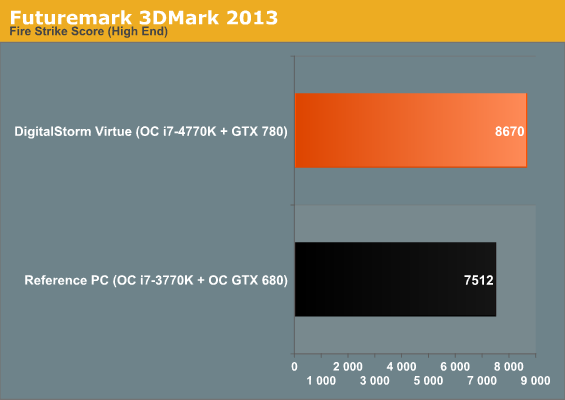
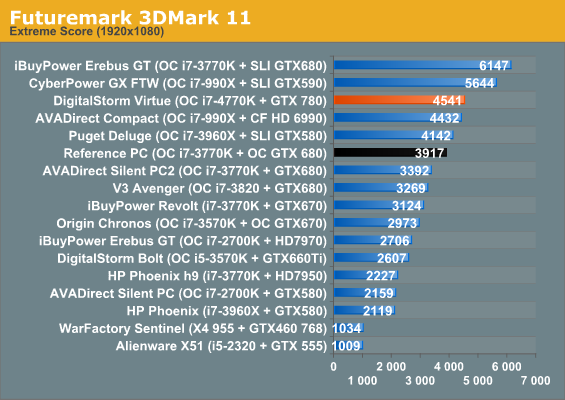
The 3DMarks pretty much tell the story. In both 3DMarks, a stock 780 is still ~15% faster than a heavily overclocked GTX 680.
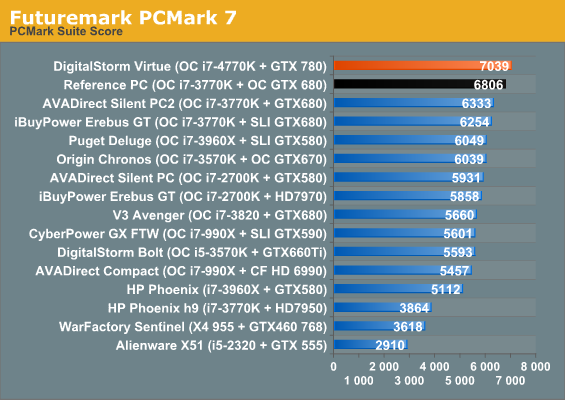
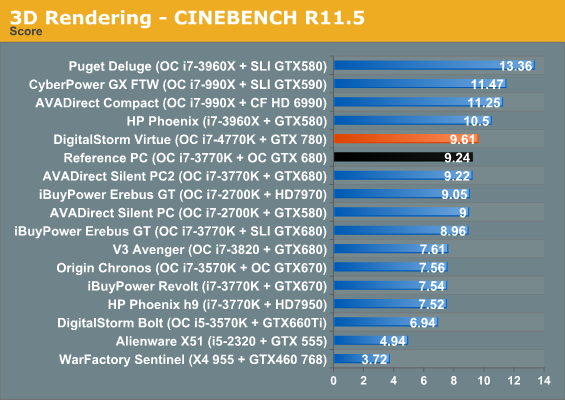
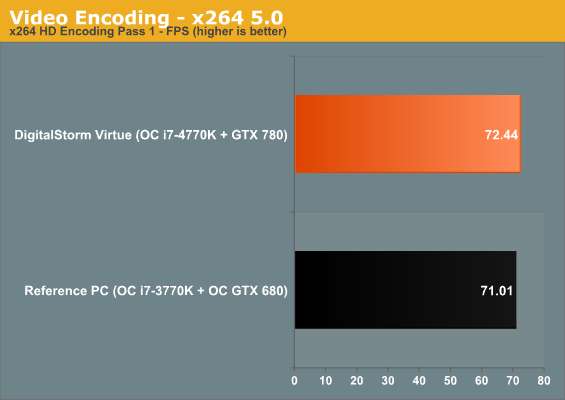
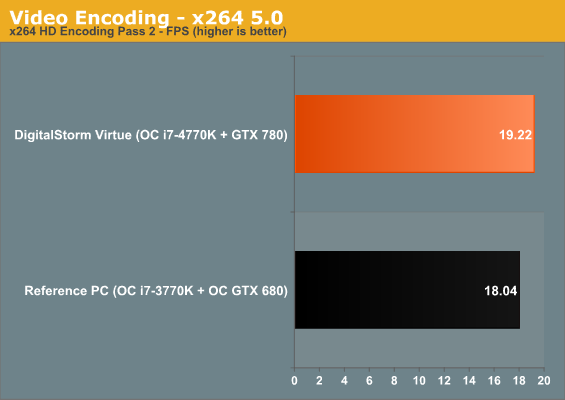
While PCMark7 tends to simply favor newer, faster SSDs, the difference between Haswell and Ivy gets a lot uglier when we isolate CPU performance. Consensus is that we've lost a bit of overclocking headroom with Haswell, making the comparison between a 4.6GHz Ivy and 4.4GHz Haswell a reasonably fair one. Cinebench is just 5% faster on Haswell, the first pass of the x264 benchmark is a dismal 2% faster on Haswell, and the second pass is at least a slightly healthier 7%.
Also note the improvement from Sandy to Ivy in Cinebench, though: our fastest Ivy is just 2% faster than our fastest Sandy. That Sandy was also running at 4.6GHz. Ivy at least brought a fat reduction in power consumption and TDP from Sandy despite the mediocre IPC improvement, but Haswell actually increased power consumption.
The math gets even uglier when we compare Sandy to Haswell. A 4.4GHz i7-4770K is only 6% faster than a 4.6GHz i7-2700K. That means that in two subsequent generations, the performance ceiling has barely moved. Anand is keen to point out that Intel's ability to eke out ~10% additional IPC on the same 22nm process node with a new architecture is impressive, and that may be true from a technical perspective, but Intel has offered enthusiasts virtually nothing new for two generations running. So whether or not the technical achievement is notable, end users are still left holding the bag. At this point, if you're hankering for more performance on the CPU, your best bet is actually to either go for an i7-3930K or wait for Ivy Bridge-E and hope Intel doesn't bone us with thermal paste instead of fluxless solder again. The only real selling point of Haswell, as far as I'm concerned, is access to the Z87 chipset.
Thankfully, while the jump in price from the NVIDIA GeForce GTX 680 to the GTX 780 isn't a particularly happy one, at least that dial moved pretty substantially. We tested every game at our Enthusiast settings (essentially maxed out and topping out at 4xMSAA), at 1920x1080 and then at 5760x1080.
|
GTX 680 1080p |
GTX 780 1080p |
% Perf. Increase |
GTX 680 Surround |
GTX 780 Surround |
% Perf. Increase |
|
| BioShock Infinite | 83.1 | 91.6 | 10.2% | 32.5 | 37.1 | 14.2% |
| Elder Scrolls V: Skyrim | 93.4 | 104.1 | 11.5% | 72.1 | 75.7 | 5% |
| GRID 2 | 87.3 | 109.2 | 25.1% | 39.4 | 49.2 | 24.9% |
| Metro: Last Light | 36.7 | 40.7 | 10.9% | 13.7 | 15.7 | 14.6% |
| Sleeping Dogs | 90 | 101.2 | 12.4% | |||
| StarCraft II: Heart of the Swarm | 73.5 | 86.2 | 17.3% | |||
| Tomb Raider | 64.3 | 72.5 | 12.8% | 31.8 | 36.5 | 14.8% |
So how do we interpret these results? First, excluding the outlying Skyrim surround results, even a diehard overclocked GTX 680 user can expect to net at least 10% more power from the GTX 780. Bumping up to 5760x1080 actually even lets the GTX 780 start to stretch its legs; while the 680 seems to be limited either by memory capacity or memory bandwidth, the 780's 384-bit memory bus and extra 1GB of GDDR5 do a solid job of picking up the slack.
Remember, too, that this is all before you overclock the 780. The consensus right now seems to be that the 780 has a very healthy amount of overclocking headroom, more than the 680 did, so if you're willing to sacrifice some power consumption and noise, you can theoretically push the 780 to Titan levels and even a bit beyond. At that point, it will pull away substantially from the 680 and by extension, the 770. I'm planning to do a custom liquid cooling review in the near future to get a grasp of just how far we can reasonably push a pair of GTX 780s, and given that I regularly see boost clocks of about 1GHz on them with just air cooling and no overclocking, I'm pretty optimistic.










70 Comments
View All Comments
Sabresiberian - Sunday, June 23, 2013 - link
My guess is that the Gryphon was getting expensive already, and Asus decided to use the lower-priced sound chip to help keep the retail price down. I mean it's already $175 in the U.S. (without the armor kit, which is another $45, heh). I don't mind because I'm not going to use the on-board sound solution anyway. (Yeah I bought a Gryphon, cause it had all the features I wanted, 5-year warranty, and I like its looks, and I bought the armor kit cause I like its looks and for the protection of any unused slots. Haven't assembled it yet as I'm waiting for the armor kit.)airmantharp - Monday, June 24, 2013 - link
I'm wondering if it matters- all Realtek codecs in the last five or so years have had decent specs and middling performance; but it doesn't take much to make them work. Good op-amps are a start, and we're seeing those on various boards.And that would be important for an mATX build; it's begging for a second GPU (why the hell else would it have twice the PSU it needs...), which would negate the use of an excellent SoundBlaster Z.
Subyman - Sunday, June 23, 2013 - link
I'm wondering why they put a 1050W PSU in a system with an ~80W CPU and ~250W GPU.JimmiG - Sunday, June 23, 2013 - link
Marketing..Anyway, 4.4 GHz is probably about as high as you want to go as boutique PC manufacturer, unless you want amass quite a collection of 4770K's that didn't make it to your target overclocked speed.
kuraegomon - Sunday, June 23, 2013 - link
Upgradability, specifically SLI, and further overclocking. Add a second 780 (admittedly a tight fit in that case), and go for broke on the overclocking CPU, GPUs and RAM, and you could end up in the 700-800 W range. For maximum PSU life, running at least 20% under maximum rating is about right.JimmiG - Sunday, June 23, 2013 - link
If the system consumes 800W, that also means it would put out 800W of heat, which would be impossible to manage with that case. Besides, it comes with a m-ATX board which means those GTX 780's would be sitting right up against each other. It would be toasty, to say the least. PSU life would be the least of my concerns.Dustin Sklavos - Sunday, June 23, 2013 - link
Consuming 800W of power does not mean producing 800W of heat. Heat generated in a computer is "waste heat," it's heat produced by energy leakage.If you look at the board, too, you'll notice a second 780 would actually be installed in the bottommost slot. That means there would be one slot of space between the two 780s, which is typical of almost any build.
Death666Angel - Sunday, June 23, 2013 - link
Electricity is energy and heat is energy and energy cannot be created or destroyed, it can only be transformed. Unless the energy the computer pulls from the socket gets transformed into electro magnetic waves or mechanical energy, it gets transformed to heat. Which is what happens to over 99% of the energy input into the PC.Not sure if you refer to something else.
jtd871 - Sunday, June 23, 2013 - link
Dustin, the heat in a computer is a reflection of *total* power draw. All that energy, waste or not, eventually turns into heat. Thus at idle, this system generates ~70W; at load, ~360W.Meaker10 - Sunday, June 23, 2013 - link
So what useful work in energy terms do we get out? Mechanical lift? Come on dustin I ex0ect more from an anandtech reviewer knowing the fundamentals :/